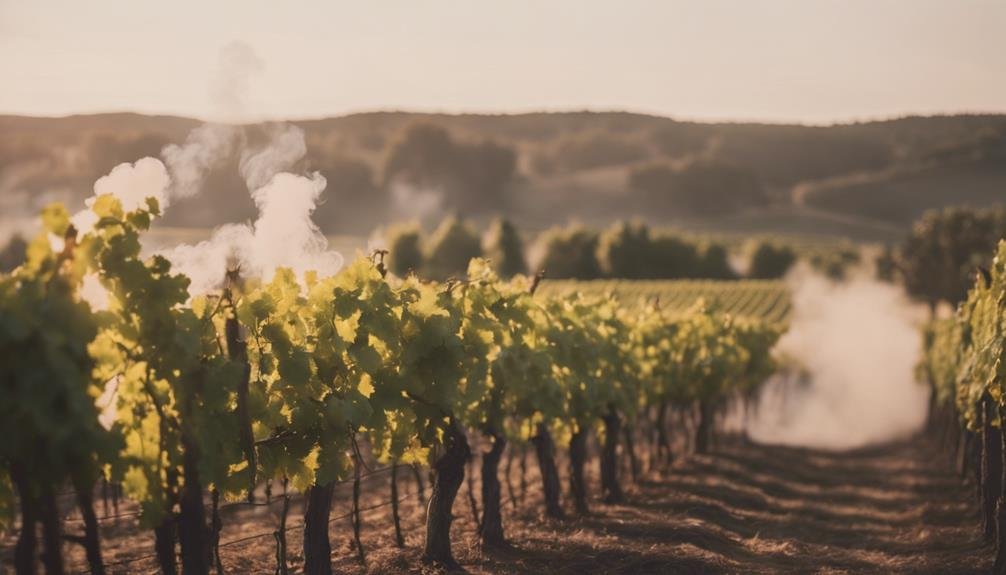Smoke taint, caused by wildfires, introduces compounds altering wine flavor. Resilient viticultural practices like canopy management mitigate effects. Hand harvesting minimizes skin damage, while keeping grapes cool reduces compound extraction. Australian research identifies unwanted compounds like guaiacol and aids in mitigation strategies development. Varying smoke proximity and intensity influence wine flavor differently. Monitoring smoke exposure from veraison to harvest is essential. Despite challenges, the wine industry remains hopeful, with successful vintages post-wildfires. Collaboration enhances understanding and management of smoke exposure. Quality wine production post-wildfires is achievable. Learn about the nuances of smoke taint's impact on wine flavor.
Wildfires and Grape Harvest Effects
Wildfires greatly impact grape harvest by posing a substantial threat to the quality and flavor profile of wines due to the potential introduction of smoke taint compounds. Climate change has exacerbated the frequency and intensity of wildfires, increasing the risks faced by vineyards.
Viticulture practices play a pivotal role in managing these challenges, with techniques like canopy management and irrigation adjustments being essential. Understanding the impact of smoke exposure on grape development is vital for mitigating smoke taint in wines.
As wildfires continue to affect vineyards worldwide, the adoption of resilient viticultural practices is becoming increasingly important to guarantee the production of high-quality wines despite these environmental challenges.
Strategies for Managing Smoke-Affected Grapes
Effective management strategies play a pivotal role in mitigating the impact of smoke exposure on grape quality and wine flavor profiles. When handling smoke-affected grapes, employing specific harvest techniques and fermentation methods can help reduce the presence of unwanted compounds in the final product. The table below outlines key strategies for managing smoke-affected grapes:
| Harvest Techniques | Fermentation Methods |
|---|---|
| Hand harvest to minimize skin damage | Exclude leaf material to reduce smoke-related characteristics |
| Keep fruit cool to extract fewer smoke-related compounds | Avoid maceration and skin contact during processing |
| Use whole bunch press to reduce smoke-derived compound extraction |
Research Insights on Smoke Taint

In-depth research conducted by the Australian Wine Research Institute has provided valuable insights into the impact of smoke taint on wine flavor profiles. Smoke taint research has explored the chemical analysis of smoke compounds, such as guaiacol and 4-methyl guaiacol, which can impart undesirable flavors to wines.
Through sensory evaluation, researchers have identified the specific characteristics that smoke taint imparts to different wine varietals. By understanding how smoke compounds interact with grape juices during winemaking, scientists can develop strategies to mitigate the effects of smoke exposure.
This research is essential for the wine industry, helping winemakers make informed decisions on how to manage smoke-affected grapes and produce high-quality wines despite the challenges posed by smoke taint.
Varied Impact of Smoke on Wines
The diverse effects of smoke exposure on wines underscore the nuanced interaction between environmental factors and grape quality. Smoke proximity and intensity can have variable impacts on wine flavor profiles, with concerns shifting throughout the grape life cycle.
Smoke exposure during veraison to harvest poses a critical period for potential taint. Despite challenges, vineyard resilience plays a significant role in determining the outcome of smoke-affected wines. Quality wines can still be produced from these vineyards, showcasing the industry's ability to adapt and mitigate smoke-related flavors.
Practical strategies, such as careful harvesting and processing techniques, can help minimize the presence of unwanted compounds in the final product, demonstrating the industry's ongoing efforts to navigate the complexities of smoke exposure.
Positive Outlook Amidst Wildfires

Amidst wildfires, the wine industry maintains a hopeful perspective on overcoming challenges and achieving quality outcomes despite smoke exposure. Historical examples demonstrate successful vintages following wildfires, showcasing resilience in the face of adversity.
Collaborative efforts between researchers and winemakers are enhancing understanding and advancing strategies to manage smoke exposure effectively. Importantly, not all fire-affected regions yield smoke-tainted wines, highlighting the potential for quality wine production even in the aftermath of wildfires.
Frequently Asked Questions
Can Smoke Taint Be Completely Removed From Affected Grapes?
Smoke taint removal from affected grapes is challenging. Industry standards suggest that complete removal is difficult. Various removal methods are being researched, but currently, complete eradication remains elusive due to the complexity of smoke taint.
Are There Specific Grape Varieties More Susceptible to Smoke Taint?
Certain grape varieties like Riesling and Pinot Noir are more susceptible to smoke taint due to thinner skins. Vineyard management practices, like early leaf removal, and sensory evaluation can aid in prevention and mitigation strategies for minimizing smoke taint impact.
How Do Wildfires Impact the Long-Term Health of Grapevines?
Wildfires can compromise grapevine resilience, impacting long-term health. Smoke exposure effects can lead to challenges such as altered growth patterns and reduced photosynthesis. Mitigating these effects through strategic management practices is essential for vineyard sustainability.
Is There a Way to Detect Smoke Taint in Grapes Before Processing?
Early detection of smoke taint in grapes before processing is essential for winemakers. Utilizing preventive strategies like sensory analysis, chemical testing, and monitoring vineyard proximity to smoke sources can help mitigate potential flavor impacts on wine.
Are There Regulations in Place for Labeling Wines Affected by Smoke Taint?
Labeling requirements for wines affected by smoke taint are evolving. Regulations vary globally, impacting consumer awareness. Transparency is key for winemakers to inform consumers. Collaborative efforts aim to standardize labeling practices for smoke-affected wines.
Conclusion
To sum up, it is noteworthy that smoke taint poses a significant challenge to winemakers worldwide, impacting grape harvests and wine flavors. Research efforts by institutions like the Australian Wine Research Institute and ongoing projects at Washington State University are shedding light on this complex issue.
Despite the variable effects of smoke exposure on wines, there is hope in the industry's ability to overcome these challenges. It is worth mentioning that studies have shown that up to 80% of wines produced from smoke-affected grapes can still be salvaged through innovative techniques.